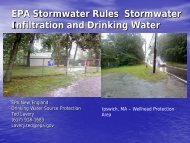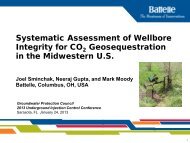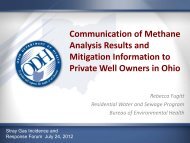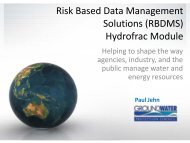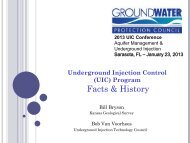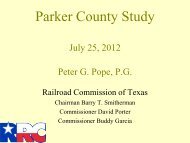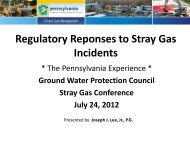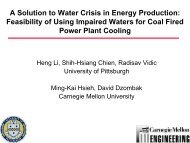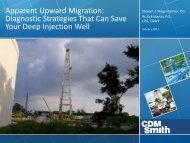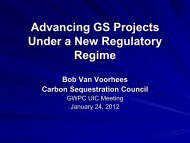The Coca-Cola Company Greg Koch - Groundwater Protection ...
The Coca-Cola Company Greg Koch - Groundwater Protection ...
The Coca-Cola Company Greg Koch - Groundwater Protection ...
You also want an ePaper? Increase the reach of your titles
YUMPU automatically turns print PDFs into web optimized ePapers that Google loves.
<strong>The</strong> <strong>Coca</strong>-<strong>Cola</strong><br />
<strong>Company</strong><br />
<strong>Greg</strong> <strong>Koch</strong>
Water is Biggest Part of Our Supply Chain and it is<br />
Under Growing Stress<br />
• Physical availability – surface<br />
or groundwater – and the<br />
sustainability of those sources<br />
• Infrastructure existence, pressure,<br />
service area, metering<br />
• Pricing – too cheap or too expensive<br />
• Droughts<br />
• Competing use and increased demand<br />
from more people and increased GDP<br />
Water Risks in Manufacturing Locations<br />
• Climate change<br />
• Regulatory limits<br />
• Social acceptance<br />
Water Risks in Agricultural Supply Chain<br />
Classified -- Internal Use<br />
2
Global Water Stress: 2010<br />
Classified - Internal use<br />
3
2020: Water Megatrends and Effects<br />
MEGATRENDS<br />
POPULATION GROWTH<br />
Expected to increase by<br />
1.5 - 8 billion by 2020<br />
CLIMATE CHANGE<br />
0.8°C temperature<br />
increase by 2020<br />
GLOBAL DEVELOPMENT<br />
Dramatic increase in<br />
number of developed<br />
economies<br />
EFFECTS<br />
1. 2/3 of world population in severe water stress<br />
2. 1/3 of world land area in severe water stress<br />
3. Significant water quality degradation<br />
4. Precipitation patterns change: more droughts<br />
and floods<br />
5. Significant increase in competition for freshwater<br />
6. More aggressive allocation , increased prices,<br />
conflict potential<br />
7. Two billion more urban residents by 2030<br />
8. Variable adaptation by public sector<br />
9. Water infrastructure needs require $1 trillion+<br />
between now and 2025<br />
4
2020 Water Stress: Rate of Change<br />
5
Future demand for water will outstrip our capacity 1 to provide it<br />
Billion m 3 , 154 basins/regions<br />
6,900<br />
2%<br />
900<br />
CAGR<br />
1,500<br />
2,800<br />
-40%<br />
Municipal &<br />
Domestic<br />
4,500<br />
600<br />
100<br />
4,200<br />
700<br />
<strong>Groundwater</strong><br />
Industry<br />
Agriculture<br />
800<br />
3,100<br />
4,500<br />
Relevant supply quantity is<br />
much lower that the absolute<br />
renewable water availability in<br />
nature<br />
3,500<br />
Surface water<br />
Existing<br />
withdrawals 2<br />
2030<br />
withdrawals 3<br />
Basins with<br />
deficits<br />
Basins with<br />
surplus<br />
Existing<br />
accessible, reliable,<br />
sustainable supply 1<br />
1 Existing supply which can be provided at 90% reliability, based on historical hydrology and infrastructure investments scheduled through 2010; net of<br />
environmental requirements<br />
2 Based on 2010 agricultural production analyses from IFPRI<br />
3 Based on GDP, population projections and agricultural production projections from IFPRI; considers no water productivity gains between 2005-2030<br />
SOURCE: 2030 Global Water Supply and Demand model; agricultural production based on IFPRI IMPACT-WATER base<br />
case<br />
McKinsey & <strong>Company</strong> | 6
We need a “resource productivity” revolution<br />
CHALLENGE<br />
Index<br />
Year 0 = 1<br />
12<br />
10<br />
8<br />
6<br />
4<br />
2<br />
0<br />
Carbon productivity<br />
growth required<br />
2008–50<br />
(Average!) Water<br />
productivity<br />
growth required<br />
2008–50<br />
U.S. labor<br />
productivity<br />
growth 1830-1955<br />
0 10 20 30 40 50 60 70 80 90 100 110 120 130<br />
Years<br />
McKinsey & <strong>Company</strong> | 7
<strong>Groundwater</strong> Stress -- India<br />
NASA’s Gravity Recovery and Climate Experiment<br />
(GRACE).<br />
8
<strong>Groundwater</strong> Stress -- India<br />
9
<strong>Groundwater</strong> Stress -- Mexico<br />
“<strong>Groundwater</strong> overuse hits Mexican state’s<br />
citrus growers”<br />
“Conagua regulates artificial aquifer<br />
replenishment to mitigate overuse”<br />
10
Food:Water:Energy Nexus<br />
Water, Energy and Food:<br />
All Three are at the Heart of the Sustainability Challenge<br />
CLIMATE CHANGE<br />
• 0.8 o C temperature increase by 2020<br />
• Manifestation in water<br />
• Unabated, climate change could cost the<br />
world at least 5% in GDP each year<br />
• If current policies are maintained, global<br />
energy demands are expected to grow<br />
by as much as 55% through 2030 and<br />
further stress water resources<br />
FOOD<br />
POPULATION GROWTH<br />
• Expected to increase by 1.5 billion<br />
to 8 billion by 2020<br />
• By 2030 the number of urban<br />
dwellers is expected to be about<br />
1.8 billion more than in 2005 and<br />
to constitute about 60% of the<br />
world’s population<br />
ENERGY<br />
WATER<br />
GLOBAL DEVELOPMENT<br />
• Dramatic increase in number<br />
of developed economies<br />
• Surging middle class<br />
11
Water Footprints<br />
12
Strategy, Goals and Partners<br />
<br />
<br />
<br />
<br />
Strategic<br />
Framework<br />
Plant Performance<br />
Watershed<br />
<strong>Protection</strong><br />
Sustainable<br />
Communities<br />
Global Awareness<br />
& Action<br />
Goals<br />
• Reduce: improve water efficiency 20% by 2012 compared with a 2004 baseline.<br />
• Recycle: 100% fully treated effluent water.<br />
• Replenish: “give back” to communities and nature as much water as we use by 2020.<br />
• Sustain: source water protection plans in all plants by the end of 2012.<br />
• Agriculture: water use, soil health and biodiversity, focus on sugarcane, oranges, corn.<br />
Key<br />
Partners<br />
Classified -- Internal Use<br />
13
Source Water <strong>Protection</strong> Requirement<br />
Strategic Intent<br />
1. Protect Manufacturing Capacity<br />
• Promote and support sustainability of<br />
water supplies<br />
• Secure long term access to sufficient<br />
quantities of sustainable water supply<br />
2. Protect Product Quality and Safety<br />
• Understand current and emerging risks to<br />
raw water quality<br />
• Ensure adequate monitoring and<br />
treatment of raw water<br />
Key Steps<br />
1<br />
2<br />
3<br />
4<br />
5<br />
Form Water Resource Management<br />
Team<br />
Complete Source Vulnerability<br />
Assessment (SVA)<br />
Prepare Source Water <strong>Protection</strong><br />
Plan (SWPP)<br />
Implement action plans<br />
Maintain/update SWPP<br />
3. Address community and broader<br />
watershed issues<br />
• Community water access/infrastructure<br />
• Watershed protection and conservation<br />
• Aquifer assessment and recharge<br />
14
Linking WRS and Replenish Programs<br />
TCCC Risk<br />
Water Resource Sustainability<br />
‣Water resources under stress<br />
Supply Reliability<br />
‣Decreased water availability<br />
Local Social<br />
‣Adverse social climate<br />
Ecological Health<br />
Aquatic Ecosystems &<br />
Species<br />
Terrestrial/Riparian<br />
Ecosystems & Species<br />
Human Health & Well-Being<br />
Safe<br />
Drinking<br />
Water<br />
Sanitation<br />
Food<br />
Availability<br />
Economics<br />
Specific Activities<br />
Watershed<br />
<strong>Protection</strong><br />
Water for<br />
Productive Use<br />
Water Access<br />
& Sanitation<br />
Education &<br />
Awareness
TCCC System Plant: <strong>Groundwater</strong> Supply<br />
Early Govt Engagement Prompted by SVA Enables Plant to Maintain<br />
Water Supply Reliability & Avoid Quality Risks<br />
SVA Learnings<br />
• Nitrate Plume in Plant’s Aquifer –<br />
Headed toward Plant<br />
• Municipality has exclusive rights to<br />
deeper aquifer<br />
Source Water <strong>Protection</strong> Actions<br />
• Engaged Municipality and procured<br />
water from deeper aquifer<br />
• Cost of Water will Increase for Plant
TCCC System Plant: <strong>Groundwater</strong> Supply<br />
SVA Provided Early Identification of Threat to Plant’s Water Supply and Highly<br />
Treasured Natural Spring. Plant Actions to Protect Spring Wins Favor with Local<br />
Gov’t and Local Activists<br />
SVA Learnings<br />
• Nutrient levels in plant water source below<br />
MCL, but rising<br />
Source Water <strong>Protection</strong> Actions<br />
• Engage municipality and community to<br />
protect aquifer and springshed<br />
• Municipality using plant’s groundwater<br />
model to support management decisions<br />
• Alleviated local social tensions previously<br />
directed toward plant (anti-bottled water),<br />
<strong>The</strong>y were previously placing signs in front<br />
of plant



